Leighton is a small village situated about a mile south-east of Welshpool, to the east of the River Severn. The village was part of the Leighton Hall estate, with its magnificent Victorian Gothic style hall as its centrepiece. Built as part of the Leighton Estate was Holy Trinity Church, reportedly one of the finest examples of a Victorian Estate Church in Wales. It was commissioned by John Naylor, and built in 1851-3 to the design of W.H. Gee, as part of a programme of building across the entire Leighton estate. Within the Churchyard is the village war memorial, in the form of a rough-hewn stone Celtic Cross, which commemorates the Parishioners who fell during both World Wars. I do not presently have any details of the names of the WW2 fallen, so have added details of four men known to have had ties to the village who fell during the latter war.
The Great War, 1914-1918
Thomas Herbert Bason, Lance Corporal, PLY/16350, Royal Marine Light Infantry. Thomas was born on 16 September 1880, the son of Wardle Bason and Frances Bason (nee Hughes), of Cwm Duggan, Trelystan. The family had moved to Surrey prior to the turn of the century, and Thomas worked as a Carpenter prior enlist into the Royal Marine Light Infantry in London on 5 July 1899. Over the coming years, he had many postings, both aboard various ships, and also on various shore stations, including at Plymouth and Chatham. On 16 July 1915 he was posted aboard pre-dreadnaught battleship, HMS Duncan, which had just been assigned to the 2nd Detached Squadron to support the Italian Royal Navy. In 1916 Duncan was sent to Salonika, following a coup led by German supporting Greek royalists. In conjunction with a similar landing of French troops, on 1 December 1916 Duncan landed a party of Royal Marines at Athens, to coerce the Greek Emperor Constantine to abdicate, however the troops were vastly outnumbered and were defeated by the Greeks, forcing the survivors to withdraw. Thomas was killed in action during the fighting that day. The 36-year-old is buried in Piraeus Naval and Consular Cemetery, Greece.
Charles Harold Longfield Beatty, DSO, Major, Royal Warwickshire Regiment. Charles was born at Howbeck, Nantwich on 16 January 1870, the son of David Longfield Beatty and Catherine Edith Beatty (nee Chaine). He was a well-known jockey and racehorse trainer, who had won the Grand International Steeplechase at Sandown in 1895 and came second in the Grand National in 1897. He was the trainer of a famous horse called Zinfandel. Charles was commissioned into the Militia in December 1888, and served in the Boer War in South Africa with the 6th Battalion, Royal Warwickshire Regiment. He was mentioned in Lord Roberts’s Despatch of 29 Oct 1900, and then won the award of the Distinguished Service Order for his actions on 17 February 1901, whilst serving as General Edwin Alderson’s Aide de Camp. Alderson sent Beatty off with a message to Major Howard, the commander of the Canadian Scouts, but as Charles arrived, he found that Howard was trapped and under fire from Boer troops. Howard ordered Charles to go for help and after two failed attempts he managed to escape, having his horse shot from under him. Major Howard was later killed by the Boers. Upon his return from South Africa, Charles married the widowed Lucy Alice Langlands (nee Beck), of Trelydan Hall. Following the outbreak of the Great War, General Alderson was in command of the Canadian Corps and asked Charles to resume his old position of Aide de Camp to him. Charles agreed, and served in France with the Canadian Corps from 1915. On 3 April 1916 he was wounded at St Eloi, and had to have his arm amputated. King George V was an admirer of Charles, and instructed his private secretary to write to him, enquiring of his health after his wound. Upon his recovery, Charles was riding one of his horses when he fell off, aggravating his wounds. He was taken to hospital for an operation, but died from complications following his wounds at Henrietta Street, Cavendish Square, London on 17 May 1917. The 47-year-old was buried with full military honours in Atherstone Cemetery, Warwickshire. Charles was a brother to Rear Admiral Sir David Beatty, commander of the Royal Navy’s Battlecruiser Fleet during the Battle of Jutland, and was step-father to Alan Langlands, who was killed in France in 1915. He is not commemorated on the Leighton war memorial.
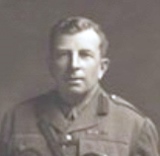
William Charles Croft, Private, 140051, Canadian Infantry. William was born at Mountain Ash on 5 April 1896, the son of Mary Elizabeth Croft (nee Parry). His mother was from Leighton, and had been widowed by 1901. His sister, Emily Croft, later lived at Pentrehouse, Leighton. William was among a number of young men aged between 12 and 13 who were sent to Canada prior to the war, embarking at Liverpool aboard the SS Canada on 16 July 1908, and became a farmer in Quebec. He enlisted into the 35th Battalion, Canadian Infantry at Toronto on 28 July 1915, and embarked for England with the battalion, landing at Liverpool on 25 October 1915, before the battalion proceeded to the Canadian Camp at Shorncliffe. Four months after arriving back in Britain, William took ill and spent sixteen weeks in hospital at Shorncliffe and Cambridge, before embarking for France on 7 June 1916, and was posted to the 20th Battalion, Canadian Infantry, which was attached to the 4th Infantry Brigade, 2nd Canadian Division. The Canadian Corps was still at Ypres, and from 2 to 13 June 1916 took part in terrible fighting during the Battle of Mount Sorrel, following a German assault upon Hill 62 which initially broke the Canadian lines. The Canadian Corps was relieved from the Ypres Salient in August 1916 and moved south, in order to take part in the Somme offensive, relieving the Australians, who had suffered terrible losses at Pozieres and Mouquet Farm. After securing the ground, the Canadians received orders to take part in a large offensive, the Battle of Flers-Courcelette, with instructions to assault and capture vantage points over the German defences from Flers to Le Sars and Pys. The 2nd Canadian Division was to attack on a one-mile front from its right flank to the Ovillers–Courcelette track, 1,000 yards to the edge of Courcelette and a 300-yard advance on the left with the 3rd Canadian Division providing a flank guard. William was killed in action during the assault, on 15 September 1916. The 20-year-old has no known grave and is commemorated on the Vimy Memorial, France.
William Edward Croft, Private, 6273, Royal Welsh Fusiliers. William was born at Worthen in 1872, the son of William Croft and Mary Ann Croft (nee Davies). His father was widowed when Mary Ann died on 11 May 1890, and William, two sisters, and a brother, were raised by their uncle, John Croft, and his wife at Pant-y-Bwlch, Leighton. William enlisted into the Royal Welsh Fusiliers as a young man, and served overseas for many years, including seeing action in China during the Boxer Rebellion in 1900. Upon completing his service, he returned to Leighton, and married Clara Elizabeth Bunnell, of Hawarden, on 18 December 1909. The couple resided at Ruffles Cottage, where two sons were born in the coming years, and William worked as a gardener to support his young family. Following the outbreak of war, William re-enlisted into his old regiment at Welshpool on 3 October 1914, and on 10 November embarked for France, joining the 2nd Battalion, Royal Welsh Fusiliers, which had recently moved to Flanders, as part of 19 Brigade. The Brigade then became attached to the 6th Division, taking over the La Boutillerie sector. On 3 December 1914 the 2nd RWF relieved the Cameronian’s in the trenches at Frelinghiem, to begin a routine tour in the trenches, William’s first such experience since re-joining the colours. The tour was to be a particularly long one, with the battalion experiencing a quiet Christmas Day in the line where the Christmas Truce was played out, and on Boxing Day the battalion was relieved, marching to billets at Erquinghem, where the New Year was celebrated. On 8 January 1915 the battalion took over new trenches at Bois Grenier, where the 6th Division was to remain over the coming months, its battalions spending their rest periods in billets at Gris-Pot. The Division was fortunate in that no major offensive took part in this sector during its period there, so its battalions mainly had to endure the day-t-day routines of trench warfare, with little casualties. On 5 May 1915 the 2nd RWF relieved the Cameronian’s to begin another routine tour in the trenches. It remained relatively quiet, apart from intermittent artillery fire, over the coming days. William was unfortunately killed during one such day, when shell fragments hit him whilst in the line on 16 May 1915. The 43-year-old has no known grave and is commemorated on the Le Touret Memorial, Richebourg-L’avoue, France. His widow, Clara, later re-married Robert Jessie Rogers, another former soldier, and died at Leighton in 1975.
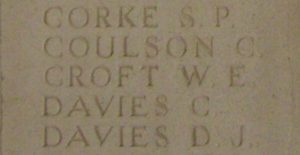
Alfred Percy Davies, Private, 14949, South Lancashire Regiment. Alfred was the son of Thomas Griffith Davies and Jane Davies, of Tank House, Leighton. He worked as a waggoner at Braggington Hall, Alberbury prior to moving to the South Wales valleys prior to the war, and found work as a Collier at Tylorstown. Alfred enlisted into the 8th Battalion, South Lancashire Regiment at Ferndale on 29 September 1914. The battalion had formed at Warrington in September 1914, moving to Codford to join 75 Brigade, 25th Division, and on 28 September 1915 Alfred embarked with the battalion for France. The Division then moved via Bailleul to the Ploegsteert sector, relieving a Canadian Division, before its infantry battalions began the usual routines of trench rotation, usually consisting of four days in the front line, four in support and four in reserve, over the coming weeks. The 8th South Lancs spent their first Christmas in France holding the front-line trenches, after receiving strict orders not to fraternise with the enemy, and two days later the battalion was relieved, moving into billets at Le Touquet and huts in Ploegsteert Wood. On 1 January 1916 the battalion relieved the Cheshire’s in the front line, and began another routine tour, enduring several days of shelling before being relieved five days later. The battalion then endured several days of shellfire whilst in their rest billets. Alfred was seriously wounded by one such bombardment on 10 January and was evacuated to hospital in Bailleul, where he died of his wounds on the following day, 11 January 1916. The 23-year-old was buried in Bailleul Communal Cemetery Extension, France. His brother, Devereux, was killed in Palestine in 1917.
Devereux Griffith Davies, Private, 290297, Royal Welsh Fusiliers. Devereux was the son of Thomas Griffith Davies and Jane Davies, of Tank House, Leighton. He trained as a Motor Engineer prior to the war, and enlisted at Welshpool into the 7th Battalion, Royal Welsh Fusiliers on 31 August 1914. The battalion was a Territorial unit, which mobilised for war at Newtown in August 1914, as part of North Wales Brigade, Welsh Division and moved to Conway until the end of the month, before moving to Northampton. In December the Division moved to Cambridge and then in May 1915 to Bedford, where the Division was numbered and the formation became 158 Brigade, 53rd (Welsh) Division. On 19 July 1915 the entire Division sailed from Devonport for Imbros and on 9 August 1915 landed at Suvla Bay. The infantry moved off the beaches into the bush, but due to a lack of maps and no knowledge of the terrain, many of the units became disorientated, and the situation became chaotic. After the fighting died down, the winter rolled in, and the men first had to endure torrential downpours, which flooded the trenches, before the snow hit, and many men began falling ill in the terrible conditions. The Division was eventually evacuated from Gallipoli in December 1915, moving to Egypt to join the EEF, and helped guard the Suez Canal before taking part in operations to drive the Turks out of the Sinai. The EEF then turned its attention onto driving the Turks out of Palestine, and on 26 March 1917 launched its first offensive against the coastal city of Gaza, which guarded the road to Jerusalem. Initial gains during the day were lost when the assaulting divisions lost touch with each other and communication broke down when a thick fog cloaked the battlefield. A second attempt to force Gaza was launched on 17 April, which also failed, and the EEF suffered a change in leadership, with Sir Edmund Allenby assuming command, before being re-organised, and a third offensive was launched against a wider front from Beersheba to Gaza on 31 October 1917. This time the Turkish defences were breached, and the road to Jerusalem now lay open and the EEF began to advance north. On 6 November 1917, 158 Brigade launched an attack on the Khuweilfeh Heights. Devereux was killed in action during the assault that day. The 22-year-old has no known grave and is commemorated on the Jerusalem Memorial, Israel. His brother, Alfred, died in France in 1916.
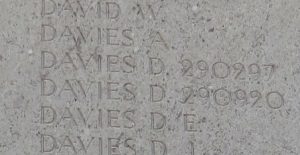
John Hugh Elton, Private, 4226, Honourable Artillery Company. John was the son of John Elton and Jane Elton, of Castle View, Leighton. He enlisted at Armoury House, London into the Honourable Artillery Company on 18 August 1915. John embarked for France at Southampton on 8 January 1916, and two weeks later joined the 1st Battalion, Honourable Artillery Company, which was by then at Blendecques, attached to G.H.Q. Troops. The HAC is one of the oldest regiments in the British Army, having been incorporated by royal charter in 1537 by King Henry VIII, and by the outbreak of war was a Territorial Army unit. The 1st HAC had a quiet first few months in France, but on 9 July 1916 joined 190 Brigade, 63rd (Royal Naval) Division, before taking part in the Battle of the Somme, and saw heavy fighting during the Battle of the Ancre, and the resulting Operations on the Ancre. In April 1917 the Division was at Arras, and fought at the Second Battle of the Scarpe, where it captured Gavrelle. John was wounded at Gavrelle on 17 April 1917, suffering multiple gunshot wounds, and was evacuated to hospital at Étaples for treatment, before being invalided to England at the end of the month. By the time he had recovered enough to re-join the battalion, it had become G.H.Q. Troops again, before becoming an officer training battalion and provided demonstration platoons. John survived the war and on 20 November 1918 was granted two weeks leave to return to Britain. He became ill soon after arriving home, and died of broncho-pneumonia at Castle View on 29 November 1918. The 25-year-old was buried in Holy Trinity Churchyard, Leighton.
John Ferguson, Private. John cannot presently be identified.
Thomas George Field, Private, 2926, Royal Welsh Fusiliers. Thomas was the son of George and Sarah Field, of 64 Liberty Hall Road, Addlestone, Surrey. His mother was originally from Narberth, in Pembrokeshire. Thomas worked as a gardener at Cockett, Swansea prior to moving to Leighton after gaining work there on the Leighton Hall Estate. He enlisted into the 7th Battalion, Royal Welsh Fusiliers at Welshpool soon after the start of the war. The battalion was a Territorial unit, which mobilised for war at Newtown in August 1914, as part of North Wales Brigade, Welsh Division and moved to Conway until the end of the month, before moving to Northampton. In December the Division moved to Cambridge and then in May 1915 to Bedford, where the Division was numbered and the formation became 158 Brigade, 53rd (Welsh) Division. On 19 July 1915 the entire Division sailed from Devonport for Imbros and on 9 August 1915 landed at Suvla Bay. The infantry moved off the beaches into the bush, but due to a lack of maps and no knowledge of the terrain, many of the units became disorientated, and the situation became chaotic. Thomas was wounded during the early days of the campaign, and was evacuated aboard the Hospital Ship Salta. Sadly, he died of his wounds at sea on 16 August 1915. The 27-year-old was buried at sea, so is commemorated on the Helles Memorial, Gallipoli.
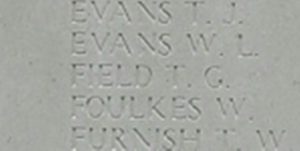
George Joseph Higgins, Lance Corporal, 1033, Royal Welsh Fusiliers. George was the son of Edward Jones Higgins and Sarah Jane Higgins (nee Middleton), of Lower Leighton Cottage, Leighton. He lodged at 17, Penllwyn Terrace, Cwmfelinfach, Ynysddu, where he worked as a coal miner. George enlisted into the 7th Battalion, Royal Welsh Fusiliers at Newtown soon after the outbreak of war. The battalion was a Territorial unit, which mobilised for war at Newtown in August 1914, as part of North Wales Brigade, Welsh Division and moved to Conway until the end of the month, before moving to Northampton. In December the Division moved to Cambridge and then in May 1915 to Bedford, where the Division was numbered and the formation became 158 Brigade, 53rd (Welsh) Division. On 19 July 1915 the entire Division sailed from Devonport for Imbros and on 9 August 1915 landed at Suvla Bay. The infantry moved off the beaches into the bush, but due to a lack of maps and no knowledge of the terrain, many of the units became disorientated, and the situation became chaotic. After the fighting died down, the winter rolled in, and the men first had to endure torrential downpours, which flooded the trenches, before the snow hit, and many men began falling ill in the terrible conditions. George was among the men who succumbed to the terrible conditions at Gallipoli, and was evacuated by Hospital Ship to Hospital in Malta, where he died of enteric fever on 15 November 1915. The 29-year-old is buried in Pieta Military Cemetery, Malta.
Herbert Hopkins, 290293, Sergeant, Royal Welsh Fusiliers. Herbert was the son of James and Emily Hopkins, of Armadale, Framfield, Sussex. He had moved to Leighton at some time after 1911, and following the outbreak of war enlisted into the 7th Battalion, Royal Welsh Fusiliers at Welshpool. The battalion was a Territorial unit, which mobilised for war at Newtown in August 1914, as part of North Wales Brigade, Welsh Division and moved to Conway until the end of the month, before moving to Northampton. In December the Division moved to Cambridge and then in May 1915 to Bedford, where the Division was numbered and the formation became 158 Brigade, 53rd (Welsh) Division. On 19 July 1915 the entire Division sailed from Devonport for Imbros and on 9 August 1915 landed at Suvla Bay. The infantry moved off the beaches into the bush, but due to a lack of maps and no knowledge of the terrain, many of the units became disorientated, and the situation became chaotic. After the fighting died down, the winter rolled in, and the men first had to endure torrential downpours, which flooded the trenches, before the snow hit, and many men began falling ill in the terrible conditions. The Division was eventually evacuated from Gallipoli in December 1915, moving to Egypt to join the EEF, and helped guard the Suez Canal before taking part in operations to drive the Turks out of the Sinai. The EEF then turned its attention onto driving the Turks out of Palestine, and on 26 March 1917 launched its first offensive against the coastal city of Gaza, which guarded the road to Jerusalem. Initial gains during the day were lost when the assaulting divisions lost touch with each other and communication broke down when a thick fog cloaked the battlefield. Herbert was killed in action during the assault that day. The 24-year-old has no known grave and is commemorated on the Jerusalem Memorial, Israel.
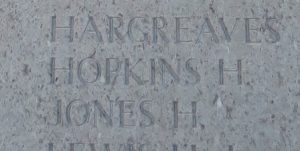
Percival Hurlbutt, Lieutenant, Montgomeryshire Yeomanry. Percival was born at Hawarden on 1 January 1908, the son of Henry Hurlbutt and Mary Joy Hurlbutt (nee Davison), of Queens Ferry Hall. He lived in White House, Leighton for several years prior to the war, having been the Agent to Captain Murray Naylor, of Leighton Hall, and had played cricket for Montgomeryshire. On 9 August 1914, Percival was commissioned as Second Lieutenant into the 7th Battalion, Royal Welsh Fusiliers. Less than three weeks later, Percival transferred to the Montgomeryshire Yeomanry as Second Lieutenant. On 5 August 1914 the Montgomeryshire Yeomanry was mobilised at Welshpool, as part of the South Wales Mounted Brigade, before moving via Hereford to Thetford, to join the 1st Mounted Division. Percival was promoted to Lieutenant in the battalion in March 1915, and in September was promoted to Captain. On 4 March 1916 the 1st Mounted Division sailed for Egypt to join the EEF. On 4 March 1917 the battalion merged with the Welsh Horse Yeomanry to form the 25th (Montgomery & Welsh Horse Yeomanry) Battalion, Royal Welsh Fusiliers, as part of the newly formed 231 Brigade, 74th (Yeomanry) Division. The Division assembled in Egypt as part of the EEF, before crossing the Suez Canal into the Sinai, and saw its first major action during the Second Battle of Gaza. The battle was a failure, and the EEF was re-organised under a new commander, Sir Edmund Allenby, before launching the Third Battle of Gaza on the night of 31 October 1917. This assault was launched along a winder front, running from Gaza to Beersheba, and this time the EEF prevailed, opening the door to Jerusalem. Percival was awarded the Military Cross for his work during the Third Battle of Gaza. The award was published in the New Year’s Honours List of 1 January 1918, and has no citation. Sadly, his health had by now began to break down, and he returned home to Britain. Percival resigned his commission in March 1918, as a result of ill-health, and was granted the Honorary rank of Captain. He died at Chester on 8 June 1918 of disease contracted whilst on active service. The 40-year-old was buried in St. Deiniol’s Churchyard, Hawarden. An elder brother, Lieutenant Colonel Charles Hurlbutt, formerly the commanding officer of the 5th Battalion, Royal Welsh Fusiliers, died in 1917.
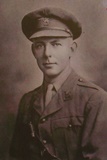
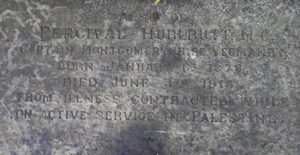
Stanley Richard Jarvis, Private, 290291, Royal Welsh Fusiliers. Stanley was the son of William and Mary Elizabeth Jarvis, of Bank House, Trewern. He enlisted into the 7th Battalion, Royal Welsh Fusiliers at Welshpool on 28 August 1914. The battalion was a Territorial unit, which mobilised for war at Newtown in August 1914, as part of North Wales Brigade, Welsh Division and moved to Conway until the end of the month, before moving to Northampton. In December the Division moved to Cambridge and then in May 1915 to Bedford, where the Division was numbered and the formation became 158 Brigade, 53rd (Welsh) Division. On 19 July 1915 the entire Division sailed from Devonport for Imbros and on 9 August 1915 landed at Suvla Bay. The infantry moved off the beaches into the bush, but due to a lack of maps and no knowledge of the terrain, many of the units became disorientated, and the situation became chaotic. The Division was eventually evacuated from Gallipoli in December 1915, moving to Egypt to join the EEF, and helped guard the Suez Canal before taking part in operations to drive the Turks out of the Sinai. The EEF then turned its attention onto driving the Turks out of Palestine, and on 26 March 1917 launched its first offensive against the coastal city of Gaza, which guarded the road to Jerusalem. Initial gains during the day were lost when the assaulting divisions lost touch with each other and communication broke down when a thick fog cloaked the battlefield. Stanley was killed in action during the fighting that day. The 22-year-old has no known grave and is commemorated on the Jerusalem Memorial, Israel.
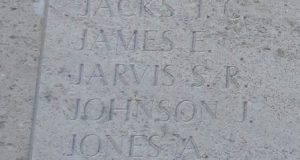
Alan Langlands, Second Lieutenant, South Wales Borderers. Alan was born at Longrood, Rugby, Warwickshire on 25 September 1894, the son of Captain John Shakespeare Langlands and Lucy Alice Langlands (nee Beck). His father died the following year, and his mother re-married Major Charles Harold Longfield Beatty, DSO, at Leighton on 31 January 1905, and the family took up residence at Trelydan Hall. Alan’s new step-father was a brother of Vice Admiral Sir David Beatty, the commander of the Royal Navy’s Battle Cruiser Fleet. With all of the military connections in the family, it was no surprise that Alan gained a commission as Second Lieutenant into the 3rd Battalion, South Wales Borderers on 7 October 1914, after completing his education at Stubbington and Wellington College. Alan embarked for France on 5 March 1915, and joined the 1st Battalion, South Wales Borderers, which was in the Festubert sector, attached to 3 Brigade, 1st Division. The battalion was enduring a torrid time, due to the weather, with the trenches being waterlogged, and men were being invalided daily due to health conditions. Alan joined the battalion in reserve at Essars on 11 March 1915. On the previous day the British had launched an offensive at Givenchy and Neuve Chapelle, to divert German attention away from a French offensive to the south at Notre Dame De Lorette. The fighting raged over the coming days, but the 1st SWB remained in reserve, within hearing distance of the fighting. On 14 March the battalion moved to billets at Hingette, where it received orders to be prepared to move at two hours’ notice, but didn’t move until 23 March, when the 1st SWB moved to Lacouture, relieving the Indians of the Jullundur Brigade in the Neuve Chapelle trenches, near Porth Arthur, on the following day. The battalion endured another torrid time in the trenches, with relentless rain and sporadic artillery fire over the coming days causing several casualties. The battalion was relieved on 31 March and moved to dugouts at Windy Corner, Cuinchy. On 7 April the battalion moved to Hingette, taking over billets in the village, and remained there for several days, carrying out a system of training. On 15 April the battalion moved into the line at Richebourg-L’avoue, and enjoyed a relatively peaceful spell before being relieved on 25 April, marching back to billets in Hingette. On 8 May the battalion left Hingette, taking over support trenches at Rue Du Bois, in order to support an assault by the 2nd Welsh on the following day. At 05.40 on 9 May 1915, the 2nd Welsh took part in an offensive known as the Battle of Aubers Ridge, but became held up by a flooded ditch and suffered heavy casualties from machine-gun fire. The 1st SWB was ordered forward to take over the original front-line trenches, but began suffering heavy casualties as the men advanced. Alan had survived this move, but at 17.00 the battalion launched an assault against the German lines, and he was shot dead as he came out of the trench. The remains of the 19-year-old were recovered from the battlefield, and he was buried in St. Vaast Post Military Cemetery, Richebourg L’Avoue, France. His step-father, Major Charles Harold Longfield Beatty, DSO, died of wounds in 1917, whilst an uncle, Second Lieutenant Noel Pryce James Turner, of the 2nd Welsh, had sadly been killed in the same action as Alan.
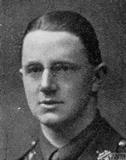
Rowland Edmund Naylor, Second Lieutenant, Royal Welsh Fusiliers. Rowland, and his twin brother Hugh, were born at Elmwood, Allerton, Lancashire on 25 April 1894, the sons of John and Magdalene Naylor. Their father was a successful banker, and by 1911 the family had moved to Leighton Hall, Welshpool, as well as owning Marrington Hall at Chirbury. Rowland was educated at Eton, where he played cricket for the school, becoming a renowned wicket keeper and batsman, He also played for Montgomeryshire, before going to Sandhurst, and was commissioned as Second Lieutenant into the 1st Battalion, Royal Welsh Fusiliers. He embarked for France with the battalion at Southampton aboard the SS Winifredian on 4 October 1914, and disembarked at Zeebrugge on 7 October. The 1st RWF was attached to 22 Brigade, 7th Division, and had gone to Zeebrugge to defend the port, but it was already in the process of falling to the Germans, so the 7th Division moved out of the city, marching via Bruges to Ostend, where the Division then entrained for Ghent. The Division then marched to Meirelbeke, and dug in defensive positions, in support of the French and Belgians. It soon became apparent that the Germans had broken through the Belgian lines, so on 11 October the 7th Division received orders to withdraw, reaching Hansbeke by the following day, and over the coming days continued to withdraw, marching through Thielt to Roulers, and by 14 October reached Ypres, becoming the first British Division to hold the city. The remainder of the BEF moved to Ypres from the Marne soon afterwards, in time to take part in the desperate defence of Ypres, when the Germans began attacking the city on 19 October. Rowland was wounded by shrapnel during the opening day of the battle, in which the BEF fought gallantly, saving the city and safeguarding the Channel ports, thus saving the war, and was evacuated to hospital, before returning to England to recuperate. He re-joined the battalion in billets at Fort D’Esquin on 9 March 1915, and enjoyed several weeks behind the lines with the battalion, which was resting following its efforts in the Battle of Neuve Chapelle. By 7 April the 1st RWF had moved to reserve billets at Rue du Bacquerot, and four days later relieved the Royal Scots in the trenches to begin a routine tour in the line, being relieved on 14 April. The battalion enjoyed another period out of the line until 6 May, when it moved forwards again, to take part in the Battle of Aubers Ridge, where the Division launched an assault against the village of Aubers on 9 May 1915. The 1st RWF remained in the assembly trenches, in support of the assault, but the attacking troops made no gains, so the battalion was not called upon, and marched to billets in Essars. On 15 May 1915 the 7th Division took part in another assault, against the village of Festubert. The 1st RWF attacked on the following day, 16 May 1915, ordered to seize the line running from the Rue Quinque to Rue D’Ouvert. The battalion seized the German front and second lines, but suffered terrible losses in doing so. Rowland was among eight officers of the battalion who fell during the day. The 21-year-old is buried in Guards Cemetery, Windy Corner, Cuinchy, France. His twin brother, Hugh Maxwell Naylor, served during the war with the 4th Hussars.
John Oliver, Private, M/288567, Army Service Corps. John was the son of John and Annie Oliver, of the Compass Inn, Fron, Forden. He worked as a Gardener prior to enlisting into the Army Service Corps at Welshpool on 28 June 1916, and was initially placed on the Army Reserve. John was mobilised at Grove Park on 12 February 1917, and joined the Motor Transport section, ASC, for training as a driver. He had been in uniform less than a month when he took ill, and died of bronchial pneumonia at Davidson Road War Hospital, Croydon on 9 March 1917. The remains of the 18-year-old were brought home for burial in Holy Trinity Churchyard, Leighton.
Evan Job Purslow, Private, G/41711, Duke of Cambridge’s Own (Middlesex) Regiment. Evan was the son of Henry Purslow and Mary Jane Purslow (nee Astley), of Worthen. He worked at Worthen Post Office prior to the war. Evan enlisted at Welshpool into the 4th Battalion, King’s Shropshire Light Infantry, and was posted to the Depot at Shrewsbury. After completing his training, Evan was drafted to France in the winter of 1916-17, and was transferred to the 19th Battalion, Middlesex Regiment. The battalion had landed in France on 2 May 1916, as the Pioneer Battalion of the 41st Division, and the entire Division moved to the Ploegsteert Sector for trench familiarisation. It remained here until August 1916, when it was relieved, and underwent a scheme of training before transferring to the Somme, and took part in the Battle of Flers-Courcelette. The Division took part in the capture of Courcelette before coming out of the line for a rest and re-fit. The Division then fought at the Battle of Le Transloy, before moving to positions south of Ypres in 1917. Here it took part in the Battle of Messines Ridge, before taking part in the Battle of Pilckem, and the Battle of the Menin Road, as part of the Third Battle of Ypres. The Division was selected as one of five British Divisions to be moved to Italy, as part of a reinforcement action taken by the Allies following a disastrous defeat of the Italian Army at Caporetto. The Division arrived at Mantua on 17 November 1917, where it held a part of the line on the River Piave, however, the crisis had passed and the Division was hurried back to the Western Front in early March 1918, and moved to the Arras sector, taking over a section of front line near Beugnatre. The Division was hit hard when the Germans launched the first phase of their Spring Offensive on 21 March 1918, and fought in the stubborn rear-guard action which ensued, reaching Ablainville by the end of the month, before being relieved and moved north to Steenvoorde. After a brief rest the Division moved into the Ypres sector, and the 19th Middlesex began work on road repairs. Luckily this sector had quietened down, so the Division enjoyed a relatively peaceful time in the coming weeks, while fighting raged to the south. The 19th Middlesex were kept busy during this period, with the many roads and paths around Ypres requiring constant repairs. Evan’s Company had just completed a gruelling period of this work early in May 1915, before marching to billets behind the lines. On 15 May 1918, Evan was resting in his billets when it was hit by a German shell, killing Evan and another man, Albert Sharpe, instantly. Evan was 21-years-old when he was killed that day, and is buried in Brandhoek New Military Cemetery No.3, Belgium.
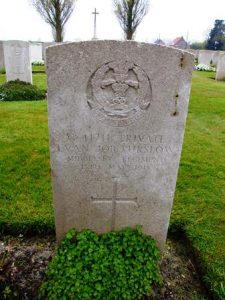
Andrew Gordon Reed, Lieutenant, Royal Welsh Fusiliers. Andrew was the son of Reverend Samuel and Bessie Reed, of Llangyniew, Montgomeryshire. Educated at Llandovery College from 1899 to 1901, Andrew was known as a strong rugby forward, and played for the school First XV. After qualifying as a Solicitor, he resided at Swan Lodge, Leighton, and was a partner in the firm of Messrs. Howell, Yearley and Reed, Welshpool. Andrew married Miss Marjorie Alston, daughter of G.G. Alston of Horringer, Bury St. Edmonds, Sussex, on 22 June 1915. He was commissioned into the 7th Battalion Royal Welsh Fusiliers on 4 May 1908, and by 10 March 1914 had been promoted to Lieutenant. The battalion was a Territorial unit, which mobilised for war at Newtown in August 1914, as part of North Wales Brigade, Welsh Division and moved to Conway until the end of the month, before moving to Northampton. In December the Division moved to Cambridge and then in May 1915 to Bedford, where the Division was numbered and the formation became 158 Brigade, 53rd (Welsh) Division. On 19 July 1915 the entire Division sailed from Devonport for Imbros and on 9 August 1915 landed at Suvla Bay. The infantry moved off the beaches into the bush, but due to a lack of maps and no knowledge of the terrain, many of the units became disorientated, and the situation became chaotic. On the following day, the 7th RWF crossed the Salt Lake, before attacking Scimitar Hill. Andrew was killed in action during the fighting which followed that day, on 10 August 1915. The 29-year-old has no known grave and is commemorated on the Helles Memorial, Gallipoli.
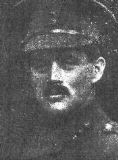
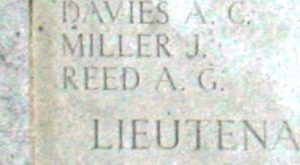
Ernest Lloyd Whettell, Lance Corporal, 703783, Canadian Infantry. Ernest was born on 27 January 1892, the son of Richard Whettell and Annie Whettell (nee Shaw), of Longwood Cottage, Trelystan, Leighton. He emigrated to Canada as a young man, sailing from Liverpool aboard the SS Laurentic on 3 June 1909, and set up home at Tow Hill, near Massett, Queen Charlotte Isles, British Columbia, and worked as a farmer. Ernest enlisted into the 102nd Battalion, Canadian Infantry at Prince Rupert on 28 February 1916, and embarked at Halifax for England with the battalion aboard the SS Empress of Britain on 18 June 1916. After disembarking in Liverpool, the battalion entrained for the Canadian Camp at Shorncliffe, where further training was carried out. On 11 August 1916 the 102nd Battalion marched from Bramshott to Liphook, where it entrained for Southampton, boarding the SS Connaught, and landed at Le Havre the following day. The battalion was attached to the 11th Infantry Brigade, 4th Canadian Division, and moved to the Ypres Salient, to the St. Eloi Sector for trench initiation, and on 24 August the Division was deemed as ready to hold the line by itself. On 17 September the Division was relieved by the 4th Australian Division, and after a brief rest period, proceeded south, to the Somme, where the men swapped their Canadian made Ross rifles for the more reliable SMLE. The Division reached Audruicq by 3 October, then marched via Gézaincourt to Vadencourt, and by 10 October had reached Albert. The 102nd Battalion moved to Tara Hill soon afterwards, remaining there until 18 October when it relieved the 87th Battalion in the front-line trenches, holding a front of 500 yards extending from Courcelette Trench on the left flank to Ross Communication Trench on the right. The Canadians were planning to complete the capture of Regina Trench, and the 102nd Battalion was heavily involved in the fighting, which was launched on 21 October. Ernest was badly wounded during the capture of Regina Trench, suffering gunshot wounds to his neck, knee, chest and buttocks, and was evacuated to the 5th General Hospital at Rouen. He died of his wounds there on 29 October 1916. The 24-year-old was buried in St. Sever Cemetery Extension, Rouen, France.
Stanley Wood, Private, G/19223, Royal Sussex Regiment. Stanley was the son of Harry Wood and Mary Jane Wood (nee Joseph), of Toxteth. His mother was from Leighton, and following the death of Harry in 1915, returned to Leighton, residing at 5, Pentre. Stanley had enlisted into the army in 1917, and was initially posted to the 13th Battalion, Royal Fusiliers. He was drafted to France in the Spring of 1918, joining the 9th Battalion, Royal Sussex Regiment. The battalion was attached to 73 Brigade, 24th Division, and had taken a battering during the heavy fighting which followed the launching of the German Spring offensive on the Somme from 21 March 1918, being hit hard at their positions near Hesbecourt and took part in a gallant rear-guard action over the Somme crossings over the coming days, before being relieved and moving to Thezy-Glimont to rest. The Division then moved north to the Maroc Sector, and saw some more fighting when the Germans launched the second phase of their Spring offensive along the Lys Valley the following month. The Division then rebuilt and refitted in the Loos Sector over the summer. Just to the south, from Arras down, the Allies had launched a massive offensive on 21 August 1918, and had begun driving the Germans towards the Hindenburg Line. At the end of September, the 24th Division was relieved, moving south to the Souchez area before joining the great offensive, moving forwards to positions east of Noyelles before joining the fight on 9 October. The Hindenburg Line had been broken by now, and during the day the 24th Division crossed the Cambrai to Caudry road, helping drive the Germans back over the River Selle, taking part the Battle of Valenciennes soon afterwards. The 9th Sussex moved to positions at Mareches, south-east of Valenciennes, by 3 November, in order to launch an offensive, as part of the Battle of the Sambre, on the following morning. The battalion attacked at dawn on the following morning, as part of a massive co-ordinated assault along that section of the front, with orders to take the high ground west of Wargnies le Petit and Wargnies le Grand, and to take the crossings over the Rhonelle River. A number of casualties were suffered from artillery and machine-gun fire during the assault, yet the battalion took its objectives, despite suffering 135 casualties. Stanley was among 35 men killed during the action that day. The 19-year-old is buried in Cross Roads Cemetery, Fontaine-au-Bois, France. His brother Charlie Wood was killed in an air raid in 1940. Stanley is not commemorated on the Leighton war memorial.
Edward Williams, Private, 9591, The King’s Shropshire Light Infantry. Edward was the son of Peter and Catherine Williams, of Gravel Lodge, Leighton. He worked as a Waggoner at Rhallt Farm, Welshpool prior to enlisting at Shrewsbury into the King’s Shropshire Light Infantry some time prior to the war, and was serving with the 2nd Battalion, King’s Shropshire Light Infantry in India when war was declared. The battalion embarked at Bombay on 13 October 1914, and upon disembarking in Plymouth some weeks later, moved to Winchester, joining 80 Brigade, 27th Division. On 21 December 1914 the Division landed at Havre, and proceeded to Blaringhem in the Ypres Salient, taking over the line near Dickebusch, at Westoutre and St. Eloi. The Division held this sector over the coming months, its infantry battalions carrying out the regular routines of trench rotation, with several days spent in the front line, several in support, and several in reserve. Whilst the Division was manning the trenches, the Royal Engineers worked hard underground, and had constructed a series of six mines beneath the German positions. At 04.15 on 27 March 1915 the mines were blown, and the troops of the 27th Division rose from their trenches to attack and capture the resulting craters, taking all bar two. The 2nd KSLI had been in reserve at Reninghelst during the battle, and by 2 April had moved to billets in Ypres, before the Division took over the Polygon Wood sector. On 22 April 1915 the Germans launched a gas attack against a sector just to the north of the 27th Division, at Gravenstafel, which was held by French Colonial troops. The French fled in terror, so the Canadian Corps was rushed in to plug the gap. The attack heralded the opening of the Second Battle of Ypres, a desperate attempt by the Germans to take Ypres, and thus open the way to the Channel ports. On 8 May the 27th Division came under attack, during the Battle of Frezenberg Ridge, and desperate fighting followed. Edward was possibly wounded at Ypres, as he was at some time transferred to the 5th Battalion, King’s Shropshire Light Infantry, which had landed at Boulogne on 20 May 1915, attached to 42 Brigade, 14th (Light) Division. The Division was in the line at Zillebeke, and had been the first Division to be attacked by the German use of flamethrowers on 30 July 1915, and took part in desperate fighting to maintain hold of the Hooge craters. On 25 September 1915 the Division launched an assault on Bellewaarde Farm, as a diversionary tactic to the main offensive which was launched to the south, at Loos, at the same time. The Division suffered heavily again for no gain, but remained in the Ypres Salient over the winter, moving to the Canal Bank sector near Boesinghe. On 11 February 1916 the 5th KSLI was holding the front line on the Canal Bank, awaiting relief. As the battalion was in the process of being relieved, a German bombing party attacked the trenches, causing over 25 casualties among the battalion. William was one of the men killed during the surprise attack that day. The 23-year-old has no known grave and is commemorated on the Ypres (Menin Gate) Memorial, Belgium.
Richard Pryce Williams, Sapper, 145807, Royal Engineers. Richard was the son of William and Margaret Williams, of Pear Tree Cottage, Leighton. He worked as a wheelwright and joiner prior to enlisting into the Royal Engineers at Welshpool on 29 February 1916, and was posted to the RE Depot at Chatham for training. He embarked for France on 22 August 1916, joining the 227th Field Company, Royal Engineers, which was attached to the 39th Division, which had just moved to the Somme. The Division saw its first major action on the Somme during the Battle of the Ancre Heights, where it captured the Schwaben Redoubt, and helped capture Regina Trench. The Division then fought at the Battle of the Ancre. The division had seen much fighting during the Somme offensive in 1916, and on 17 November entrained from Gézaincourt for Flanders, enjoying a brief rest before moving into the Ypres Salient, taking over positions on the Canal Bank near Chateau des Trois Tours. In January 1917 the Division took over the Railway Wood sector, and its infantry battalions began the regular routines of trench rotation. The Division remained at Ypres over the coming months, and on 31 July 1917 took part in the opening assault of the Third Battle of Ypres, the Battle of Pilckem Ridge. After some fierce fighting, the Division went into reserve for a short rest, before moving back into the front line at the Shrewsbury Forest sector, and took part in another series of attacks, as part of the Battle of the Menin Road. The Division then fought at the Battle of Polygon Wood and the Second Battle of Passchendaele. Richard returned home on two weeks leave in November 1917, and re-joined the Division at Zonnebeke, where it wintered. In February 1918 the Division moved to positions near Péronne and took over positions near Tincourt. On 21 March 1918 the Germans launched the first of three major offensives, along the section of Western Front running south from Croisilles to La Fère. Richard’s Company was ‘Stood-To’ at Tincourt, before moving to Gurlu Wood, and began working on defensive positions on the Saulcourt Switch. As fighting raged all along the front, on 23 March the Company was ordered to dig a defensive position east of Bussu, for the withdrawing infantry to use to attempt to stem the German advance. Soon afterwards the Germans attacked, and the 227th Company withdrew, under cover of machine-gun fire, to Péronne, where the men crossed the Somme before marching to Clery, as the line was pushed further back. Richard was posted as missing on or since 23 March 1918, and no trace of him was ever seen again, so he was later assumed to have been killed in action on 25 March 1918. The 23-year-old has no known grave and is commemorated on the Pozieres Memorial, France.
World War Two, 1939-1945
James Edward Alexander, Able Seaman, D/JX 165241, Royal Navy. James was born on 3 November 1918, the son of William Henry Alexander and Annie Alexander (nee Stocker), of Rolan, Leighton. James enlisted into the Royal Navy as a young man, and by the time war erupted was posted aboard the recommissioned WW1-era V-class destroyer HMS Venetia. During October 1939, she began service escorting convoys in the North Atlantic Ocean, then took part in a Mediterranean Convoy before being transferred to Nore Command in May 1940, to assist in the evacuation of troops from the Netherlands, Belgium, and France. She formed part of the escort group which transported the Dutch Royal Family to safety in Britain, and then on 23 May 19140 took part in the efforts to evacuate troops of the Irish Guards and Welsh Guards, who had been trapped at Boulogne. Venetia was struck by a number of shells fired from a German Panzer, and set ablaze, but managed to limp back to Dover, before undergoing repairs. She was then returned to Nore Command in August 1940 and began convoy defence and patrol duties in the North Sea and Thames Estuary in September 1940. On 19 October 1940, she was on patrol in the Thames Estuary when she struck a mine off Knob Buoy and sank. James was killed in the sinking. The body of the 22-year-old was later recovered from the sea, and he was buried in Gillingham (Woodlands) Cemetery, Kent.
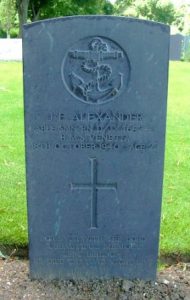
John Macalister Alexander, Fusilier, 4194689, Royal Welch Fusiliers. John was the son of Thomas Alexander and Margaret Alexander (nee Davidson), of Leighton. He enlisted into the Royal Welch Fusiliers, but then volunteered for Commando training, training at the Combined Training Centre at Inveraray, Argyll, before being posted to No 1 Commando. The unit included a large number of men of the Royal Welch Fusiliers and Welch Regiment TA battalions, and began raids on the French Coast after its formation. One troop from 1 Commando took part in the raid on St Nazaire where Sergeant Tom Durrant was awarded the Victoria Cross. In 1942 No1 Commando was then withdrawn from raiding to prepare for the North African operations and landings, code-named ‘Operation Torch’. The landings began on 8 November 1942, with No 1 Commando landing at Algiers alongside the American 34th Division, but met no real resistance from the Vichy French defenders. The Allies then consolidated in Algeria, before launching their campaign in Tunisia. No 1 Commando moved by Landing Craft to Tabarka on 26 November, and took part in the capture of Fort D’Estrée and the Batterie de Lazaret on the east side of the Bay of Algiers. John was killed around this time, on 11 December 1942. The 22-year-old is buried in Bone War Cemetery, Annaba, Algeria.
Fredrick Ewart Gwilt, Lance Corporal, 4196205, Manchester Regiment. Frederick was the son of Herbert Gwilt and Martha Maud Gwilt (nee Humphreys) of Roundabout, Leighton. He enlisted into the army after the outbreak of war, and was posted to the 8th Battalion, Manchester Regiment. The battalion was sent to Malta in May 1940 and became part of the Northern Infantry Brigade, later redesignated 2nd Malta Infantry Brigade and, finally, 232nd Infantry Brigade. In late July 1943, the 8th Manchester’s was transferred to the 10th Indian Infantry Division, which was serving in North Africa. Following the surrender of the Afrika Korps, the Allies invaded Sicily, before landing on mainland Italy, and the 8th Manchester’s then took part in the Italian campaign from March 1944. Frederick was killed in Italy on 9 August 1944. The 25-year-old is buried in Arezzo War Cemetery, Italy.
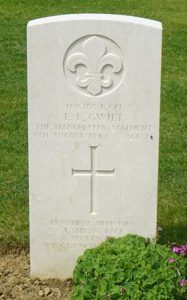
Charlie Wood, Civilian. Charlie was born in Liverpool in 1894, the son of Harry Wood and Mary Jane Wood (nee Joseph). Following the death of his father in 1915, his mother moved back to her native Leighton, and resided at 5, Pentre. Charlie had served with the Royal Engineers during the Great War. He married Louisa Hodkinson in 1919, and the couple resided at 123, Moss Lane, Liverpool. Charlie enlisted into the Auxiliary Fire Service following the outbreak of war, and was based at the Green Lane AFS Station, Liverpool. The AFS personnel had a terrible time following the launching of the Liverpool Blitz on 28 August 1940, when the city was attacked by a force of 160 German bombers. The attacks continued for three solid days, then at regular periods over the coming months, as the Luftwaffe sought to disrupt the city’s dockyards. On 17 September 1940 a number of bombers dropped their loads onto the city, causing terrible damage at Church Lockerby Road and Green Lane, Old Swan. Charlie was in the Green Lane Station that day, during shift handover, when it suffered a direct hit from a bomb, bringing down the building and killing eight firemen. Charlies was 46-years-old when he was killed that day. He was buried in West Derby Cemetery, Liverpool. One of his brothers, Stanley, had been killed in France in 1918.